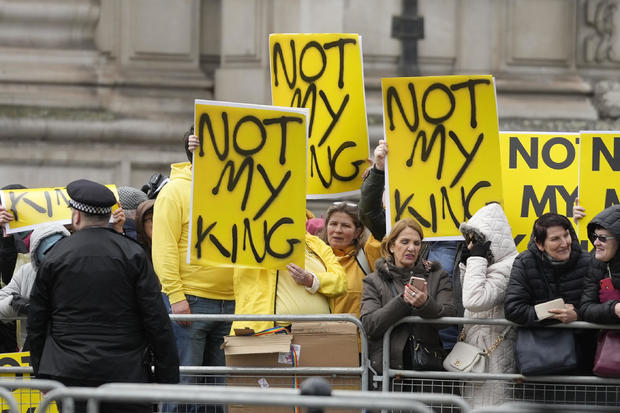Live updates: King Charles III coronation day coverage from the scene of the ceremony
How to watch the coronation of King Charles III
Click here for a schedule of the expected events during the hours-long coronation processions and ceremony.
Arrests as anti-monarchy protests planned for coronation day
Protests against the British monarchy were planned around the United Kingdom for the day of the coronation by the anti-monarchy group Republic. Early Saturday morning, Republic said its leader was among several people arrested as they showed up to stage a demonstration at London’s Trafalgar square.
Police did not immediately confirm any arrests, but they had warned against any attempts to disrupt the day’s proceedings. There were reports that some protesters had planned to try to do just that, interfering with the processions, according to U.K. Deputy Prime Minister Oliver Dowden. He said the government had received intelligence that some people might try to spook horses on the procession route by sounding rape alarms.
Republic wants Britain’s monarch to be replaced as the official head of state by an elected official. Republic is either organizing or promoting peaceful rallies in England and Scotland.
Frank Augstein/AP
Click here to read a full story on the planned protests.
What’s the point, and what happens at a coronation?
Coronation ceremonies came out of an historic need to bring stability to European monarchies amid competing claims to their thrones, as well as traditions of church involvement in the state. They do not take place immediately after the death of the previous monarch to allow time for the country to grieve. The ceremony is largely religious, and it does not bring King Charles any further privileges as the monarch, which he has been since the moment his mother died.
British coronations are carried out by the Anglican Church, otherwise known as the Church of England. The only part of the coronation ceremony required under British law is the Coronation Oath. The exact wording of which has varied over the centuries, and it has been updated for Charles to reflect a more modern Britain.
After the oath, the king will be anointed with holy oil by the Archbishop of Canterbury, Justin Welby, who will pour the oil onto a spoon and anoint Charles’ hands, head and breast. Then, Charles will be given the royal robe, the orb, the coronation ring, the sceptre and the rod of his position. Finally, at the “moment of coronation,” St. Edward’s Crown will be placed on his head.
Here’s the schedule of events for coronation day
King Charles and Camilla, his queen consort, will begin to travel from Buckingham Palace to Westminster Abbey in a procession at 5:20 a.m. Eastern, 10:20 a.m. local time. The route they will take is 1.3 miles long, directly through central London.
The coronation ceremony will begin at Westminster Abbey at 6:00 a.m. Eastern, 11:00 a.m. local time and is expected to last for about two hours. Afterwards, they will travel in a procession back to Buckingham Palace.
Click here for a full schedule of the coronation events and to learn how to watch the ceremony from wherever you are.
For all the latest World News Click Here
For the latest news and updates, follow us on Google News.


